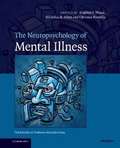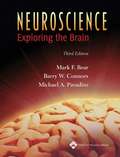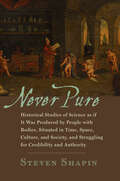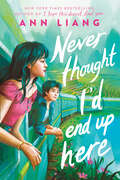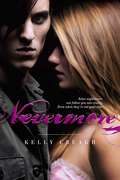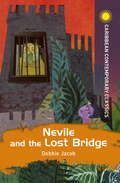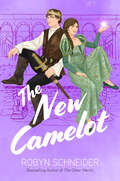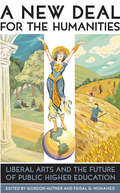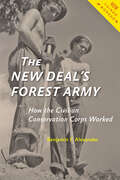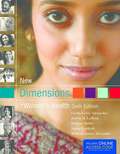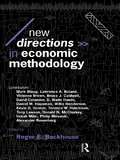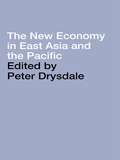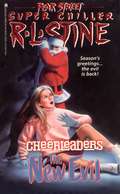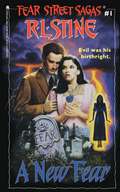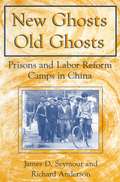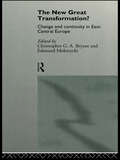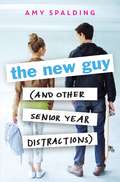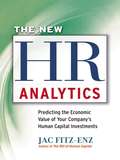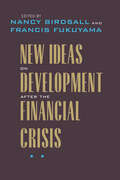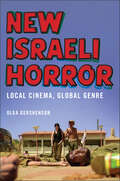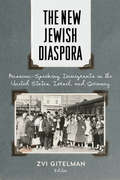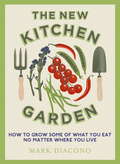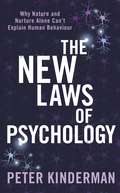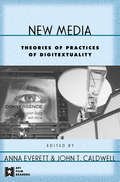- Table View
- List View
The Neuropsychology of Mental Illness
by Stephen J. Wood Nicholas B. Allen Christos PantelisIt is widely accepted that most psychiatric disorders are associated with cognitive impairment and that neuropsychological approaches can help unravel the mechanisms underlying brain function and help us develop a better understanding of these disorders. In this book, a panel of the world's leading experts describe the development of neuropsychological approaches to the investigation, description, measurement and management of a wide range of mental illnesses. Part One explains the rationale for examining neuropsychological processes within clinical disorders, leading into Part Two summarizing and critiquing the methodological approaches to study. Part Three covers each of the major psychiatric disorders and provides a summary of the neuropsychological findings for each condition. The final section brings together the perspectives of neuroscientists, psychiatrists and philosophers. Essential reading for all those studying the healthy as well as the disordered brain, The Neuropsychology of Mental Illness will appeal to specialists from the fields of mental health, psychology, clinical neuroscience and philosophy.
Neuroscience: Exploring the Brain (Third Edition)
by Mark F. Bear Barry W. Conners Michael A. ParadisoNeuroscience: Exploring the Brain surveys the organization and function of the human nervous system, presenting material at the cutting edge of neuroscience, in a way that is accessible to both science and nonscience students alike. The book is divided into four parts: Part I, Foundations; Part II, Sensory and Motor Systems; Part III, The Brain and Behavior; and Part IV, The Changing Brain.
Never Pure: Historical Studies of Science as if It Was Produced by People with Bodies, Situated in Time, Space, Culture, and Society, and Struggling for Credibility and Authority
by Steven ShapinSteven Shapin argues that science, for all its immense authority and power, is and always has been a human endeavor, subject to human capacities and limits. Put simply, science has never been pure. To be human is to err, and we understand science better when we recognize it as the laborious achievement of fallible, imperfect, and historically situated human beings.Shapin’s essays collected here include reflections on the historical relationships between science and common sense, between science and modernity, and between science and the moral order. They explore the relevance of physical and social settings in the making of scientific knowledge, the methods appropriate to understanding science historically, dietetics as a compelling site for historical inquiry, the identity of those who have made scientific knowledge, and the means by which science has acquired credibility and authority.This wide-ranging and intensely interdisciplinary collection by one of the most distinguished historians and sociologists of science represents some of the leading edges of change in the scholarly understanding of science over the past several decades.
Never Thought I'd End Up Here
by Ann LiangFrom the author of the instant New York Times bestseller I Hope This Doesn't Find You comes another hilarious and romantic romcom, this time following a former model determined to get revenge on the boy who ruined her life.Leah Zhang has just ruined her cousin's wedding. She didn't mean to wish the bride a depressing marriage and poor health, but she's forgotten most of her Mandarin. Her parents stage an intervention: Leah will be sent on a travel program across China's most beautiful cities. To them, it's the perfect opportunity for Leah to get back to her roots. To Leah, it's simply a much-needed escape.But before Leah can even begin to enjoy the luxurious hotels, stunning scenery, and mouth-watering cuisine, she finds that also on the trip is cynical, sarcastic Cyrus Sui, who's somehow only gotten more annoyingly handsome since the day he told a lie that ruined her life. While Leah might be tempted to shove him off the peak of the Yellow Mountain when nobody's looking, she can't get rid of him just yet. After all, she might never get another chance to get revenge.Yet the deeper they wander into China's provinces, the deeper Leah finds herself falling in love - with the boy she once thought she despised, the home she never thought she'd call her own, and the parts of herself she thought were already lost.
Nevermore: A Nevermore Book (The Nevermore Books)
by Kelly CreaghA page-turning psychological mystery that is equal parts horror, humor, and romance, Nevermore is the story of Varen—a Poe fan and Goth—and Isobel—a cheerleader and unlikely heroine. When an English Lit. project pairs the two, Isobel finds herself swept into Varen’s world, one that he has created in his notebook and in his mind, one where the terrifying stories of Edgar Allan Poe come to life. Isobel slowly learns that dreams and words can be much more powerful than she’d ever imagined. As labels of “Goth” and “cheerleader” fade away, Isobel and Varen slip into a consuming romance, braced against the ever-clearer horror that the most chilling realities are those within our own minds. When Isobel has a single chance to rescue Varen from the shadows of his nightmares, will she be able to save him—and herself? Included in this eBook edition of Nevermore, enjoy a free collection of Edgar Allan Poe’s poems and short stories!
Nevile and the Lost Bridge
by Debbie JacobThere have been many great and enduring works of literature by Caribbean authors over the last century. The Caribbean Contemporary Classics collection celebrates these deep and vibrant stories, overflowing with life and acute observations about society.In the year 2222, Neville and his friends Nina and A.T. are elite bridge builders in the province of Aribbea, where children go to work, adults go to school, and everyone is ruled by a tyrannical king. No-one remembers what life was like before the calamitous event which brought the king to power, and enabled him to lock up all secrets and memory in his own library. Aribbeans now have no memory, and no understanding of the world outside the bridges on which they live. When Neville, Nina and A.T. find themselves plunging from a bridge to the land and sea below, they have no idea what will befall them. Sometimes together, sometimes apart, each must make his or her way through the tests and challenges which await them, to find their true place and to begin to recover their history. Accompanied by a varied cast of companions, they encounter Pierre the Bacoo, Papa Bois, the rasta Hunn Dread, Hanuman the monkey and the last dog in Arribea. This motley crew succeeds in posing the first real challenge to his rule which the king has ever faced. What does friendship and loyalty mean? How do we know when we are safe, and what makes us so? Who can we trust?
The New Camelot (Emry Merlin #3)
by Robyn SchneiderSayeth it ain't so! The finale to the epic Emry Merlin trilogy is here, with all the sorcery, snark, and high stakes that made The Other Merlin one of Publishers Weekly&’s Best Books of the Year!Everything is finally going right for Emry Merlin. Now that Arthur is the king and her wayward magic is under control, she&’s enjoying life as Camelot&’s official court wizard—and as Arthur&’s girlfriend.But when an unexpected visitor arrives at court, Emry finds her hard-won position threatened. And Arthur is torn between listening to his advisors and following his heart. Even more troubling, war is on the horizon, with King Yurien&’s access to dark magic ensuring Camelot&’s doom. That is, unless Emry, Arthur, and Lance can find a way to defeat the evil sorceress Bellicent with magic from her own world. But undertaking a quest to Anwen is perilous business, and our young heroes will face many obstacles on their journey—from dangerous beasts to suspicious nobles to cursed maidens determined to find someone to marry.Can Emry and Arthur save their kingdom and fix their relationship, or will they have to choose between their future and Camelot&’s?
A New Deal for the Humanities
by Feisal G. Mohamed Jeffrey J. Williams Christopher Newfield Kathleen Woodward Gordon Hutner Roger L. Geiger Daniel Lee Kleinman John Mcgowan Charlotte Melin Sheldon Rothblatt Yolanda Moses Bethany NowviskieMany in higher education fear that the humanities are facing a crisis. But even if the rhetoric about "crisis" is overblown, humanities departments do face increasing pressure from administrators, politicians, parents, and students. In A New Deal for the Humanities, Gordon Hutner and Feisal G. Mohamed bring together twelve prominent scholars who address the history, the present state, and the future direction of the humanities. These scholars keep the focus on public higher education, for it is in our state schools that the liberal arts are taught to the greatest numbers and where their neglect would be most damaging for the nation. The contributors offer spirited and thought-provoking debates on a diverse range of topics. For instance, they deplore the push by administrations to narrow learning into quantifiable outcomes as well as the demands of state governments for more practical, usable training. Indeed, for those who suggest that a college education should be "practical"--that it should lean toward the sciences and engineering, where the high-paying jobs are--this book points out that while a few nations produce as many technicians as the United States does, America is still renowned worldwide for its innovation and creativity, skills taught most effectively in the humanities. Most importantly, the essays in this collection examine ways to make the humanities even more effective, such as offering a broader array of options than the traditional major/minor scheme, options that combine a student's professional and intellectual interests, like the new medical humanities programs. A democracy can only be as energetic as the minds of its citizens, and the questions fundamental to the humanities are also fundamental to a thoughtful life. A New Deal for the Humanities takes an intrepid step in making the humanities--and our citizens--even stronger in the future.
The New Deal's Forest Army: How the Civilian Conservation Corps Worked (How Things Worked)
by Benjamin F. AlexanderHow the Civilian Conservation Corps constructed, rejuvenated, and protected American forests and parks at the height of the Great Depression.Propelled by the unprecedented poverty of the Great Depression, President Franklin D. Roosevelt established an array of massive public works programs designed to provide direct relief to America’s poor and unemployed. The New Deal’s most tangible legacy may be the Civilian Conservation Corps’s network of parks, national forests, scenic roadways, and picnic shelters that still mark the country’s landscape. CCC enrollees, most of them unmarried young men, lived in camps run by the Army and worked hard for wages (most of which they had to send home to their families) to preserve America’s natural treasures. In The New Deal’s Forest Army, Benjamin F. Alexander chronicles how the corps came about, the process applicants went through to get in, and what jobs they actually did. He also explains how the camps and the work sites were run, how enrollees spent their leisure time, and how World War II brought the CCC to its end. Connecting the story of the CCC with the Roosevelt administration’s larger initiatives, Alexander describes how FDR’s policies constituted a mixed blessing for African Americans who, even while singled out for harsh treatment, benefited enough from the New Deal to become an increasingly strong part of the electorate behind the Democratic Party. The CCC was the only large-scale employment program whose existence FDR foreshadowed in speeches during the 1932 campaign—and the dearest to his heart throughout the decade that it lasted. Alexander reveals how the work itself left a lasting imprint on the country’s terrain as the enrollees planted trees, fought forest fires, landscaped public parks, restored historic battlegrounds, and constructed dams and terraces to prevent floods. A uniquely detailed exploration of life in the CCC, The New Deal’s Forest Army compellingly demonstrates how one New Deal program changed America and gave birth to both contemporary forestry and the modern environmental movement.
New Dimensions in Women's Health (6th Edition)
by Linda Lewis Alexander Judith H. Larosa Helaine Bader Susan GarfieldNew Dimensions in Women's Health: Sixth Edition is a comprehensive and practical text that offers students the tools to understand the health of women of all cultures, races, ethnicities, socioeconomic backgrounds, and sexual orientations. The fully revised and updated sixth edition gives women critical information needed to optimize their well-being, avoid illness and injury, and support their health. Each chapter presents in-depth coverage of an important aspect of women's health and examines the contributing epidemiological, historical, psycho-social, cultural, ethical, legal, political, and economic influences. This text is appropriate for undergraduate students studying Health Education, Nursing, and Women's Studies as well as students in general health education electives.
New Directions in Economic Methodology (Economics As Social Theory Ser.)
by Roger E. BackhouseIn recent years there has been a flowering of work on economic methodology. However there is no longer any consensus about which direction this should take or, indeed, even what the role and content of economic methodology should be. This book reflects this diversity. Its contributors are responsible for the major developments in this field and tog
The New Economy in East Asia and the Pacific (PAFTAD (Pacific Trade and Development Conference Series) #10)
by Peter DrysdaleThis book sets out the problems of measuring the effects of technological change on economic progress by using the internet in the Asia-Pacific region as a case study. Corporate and industry experience, including changing business organization and new regulatory issues are explored as well as policy issues such as the digital divide and the approach to e-commerce in the WTO. Using several industry case studies the contributors compare the IT experience in North America with a number of countries in Asia and the Pacific.
The New Evil (Fear Street Cheerleaders)
by R.L. StineCorky and the Shadyside cheerleaders are sure that the evil spirit is destroyed. The terror is over. Then Hannah is mysteriously thrown through the car window. And Naomi is nearly burned to death. One horrifying accident after another. And now Corky can no longer keep her greatest fear to herself—the evil is back! But where is it? Corky, Kimmy, and Debra aren’t waiting to find out. They have a plan to draw the evil out and destroy it for good. Unless, of course, the evil destroys them first...
A New Fear: A New Fear; House Of Whispers; Forbidden Secrets (Fear Street Saga #1)
by R.L. StineThe Fear name brings fortune...and doom. The dark power of the Fear family consumes all those connected with it. The Fears. Those they love -- and hate. The entire town of Shadyside. All are tainted forever by the evil of the family's curse. No one can escape. Nora Goode and Daniel Fear hoped to end the curse of the Fear family. But on their wedding day, a horrible fire swept through the Fear mansion, taking the life of every member of the doomed family. Except one. A new Fear. The child of Nora and Daniel. Will he be able to live his life untouched by the evil of his family? Or will the dark forces claim yet another Fear for their own?
New Ghosts, Old Ghosts: Prisons and Labor Reform Camps in China (Socialism And Social Movements Ser.)
by James D. Seymour Michael R AndersonMuch has been written about the laogai (sometimes likened to the Soviet gulag) in the People's Republic of China. Depending on the source, the prisons are described as nonexistent, enlightened institutions, or hellish places that subject the inmates to degradation and misery. The system is commonly thought of (by admirers and critics alike) as having a measurable impact on the national economy and providing significant resources to the state. Based on research in classified documents and extensive interviews with former prisoners, judicial personnel, and other insiders, and featuring case studies dealing with the three northwestern provinces, this book examines such assertions on the basis of the facts about this underexamined subject in order to arrive at a detailed, objective, and realistic picture of the situation. In the case of each province under study, the authors discuss the history of the provincial prison system and the impact that each has had at the macro, meso, and micro levels.
The New Great Transformation?: Change and Continuity in East-Central Europe
by Christopher G.A. Bryant Edmund MokrzyckiThis timely and assured book provides an essential guide to one of the biggest social, political and economic developments of our time.
The New Guy (and Other Senior Year Distractions)
by Amy SpaldingFilled with romance, rivalry, and passive-aggressive dog walking, Amy Spalding delivers a hilariously relatable story about how even the best-laid plans sometimes need to be rewritten.What's the only thing that could derail overachiever Jules's perfect senior year? Alex Powell--former member of boy-band sensation Chaos 4 All and newest transfer to Eagle Vista Academy. Alex seems cool enough when he starts spending time with Jules. In fact, he turns out to be quite the romantic (not to mention a killer kisser). And after getting over the initial shock that someone like Alex might actually like like her, Jules accepts that having a boyfriend could be a nice addition to her packed schedule. That is, until Alex commits the ultimate betrayal, which threatens to ruin her high school career, and possibly her entire future. This. Means. War.
The New HR Analytics: Predicting the EconomicValue of Your Company's Human Capital Investments
by Jac Fitz-EnzIn his landmark book The ROI of Human Capital, Jac Fitz-enz presented a system of powerful metrics for quantifying the contributions of individual employees to a company’s bottom line. The New HR Analytics is another such quantum leap, revealing how to predict the value of future human capital investments. Using Fitz-enz’s proprietary analytic model, readers learn how to measure and evaluate past and current returns. By combining those results with focused business intelligence and applying the exclusive analytical tools in the book, they will be able to: Evaluate and prioritize the skills needed to sustain performance • Build an agile workforce through flexible Capability Planning • Determine how the organization can stimulate and reward behaviors that matter • Apply a proven succession planning strategy that leverages employee engagement and drives top-line revenue growth • Recognize risks and formulate responses that avoid surprises • Support decision making by predicting the actions that will yield the best returns Brimming with real-world examples and input from thirty top HR practitioners and thought leaders, this groundbreaking book ushers in a new era in human resources and human capital management.
New Ideas on Development after the Financial Crisis (Forum on Constructive Capitalism)
by Nancy Birdsall, Francis FukuyamaThe global financial crisis of 2008–9 has changed the way people around the world think about development. The market-friendly, lightly regulated model of capitalism promoted by the United States is now at risk, and development thinking worldwide is at something of an impasse. Editors Nancy Birdsall and Francis Fukuyama bring together leading scholars to explore the implications of the global financial crisis on existing and future development strategies.In addressing this issue, the contributors contemplate three central questions: What effect has the crisis had on current ideas in development thinking? How has it affected and how will it affect economic policy and political realities in Latin America and Asia, including China and India? Will the financial collapse reinforce shifts in geopolitical power and influence, and in what form? Essays answering these questions identify themes that are essential as economic and political leaders address future challenges of development.To help move beyond this time of global economic turmoil, the contributors—the foremost minds in the field of international development—offer innovative ideas about stabilizing the international economy and promoting global development strategies. Contributors: Nancy Birdsall, Center for Global Development; Michael Clemens, Center for Global Development; Kemal Derviş, Brookings Institution; Larry Diamond, Stanford University; Francis Fukuyama, Stanford University; Peter S. Heller, Johns Hopkins University; Yasheng Huang, Massachusetts Institute of Technology; Justin Yifu Lin, World Bank; José Antonio Ocampo, Columbia University; Mitchell A. Orenstein, Johns Hopkins University; Minxin Pei, Claremont McKenna College; Lant Pritchett, Harvard University; Liliana Rojas-Suarez, Center for Global Development; Arvid Subramanian, Johns Hopkins University
New Israeli Horror: Local Cinema, Global Genre
by Olga GershensonBefore 2010, there were no Israeli horror films. Then distinctly Israeli serial killers, zombies, vampires, and ghosts invaded local screens. The next decade saw a blossoming of the genre by young Israeli filmmakers. New Israeli Horror is the first book to tell their story. Through in-depth analysis, engaging storytelling, and interviews with the filmmakers, Olga Gershenson explores their films from inception to reception. She shows how these films challenge traditional representations of Israel and its people, while also appealing to audiences around the world. Gershenson introduces an innovative conceptual framework of adaptation, which explains how filmmakers adapt global genre tropes to local reality. It illuminates the ways in which Israeli horror borrows and diverges from its international models. New Israeli Horror offers an exciting and original contribution to our understanding of both Israeli cinema and the horror genre. A companion website to this book is available at https://blogs.umass.edu/newisraelihorror/ (https://blogs.umass.edu/newisraelihorror/) Book trailer: https://youtu.be/oVJsD0QCORw (https://youtu.be/oVJsD0QCORw)
The New Jewish Diaspora: Russian-Speaking Immigrants in the United States, Israel, and Germany
by Sveta Roberman Uzi Rebhun Jonathan Dekel-Chen Adrian Wanner Nelly Elias Mikhail Krutikov Steven J. Gold Mark Tolts Hannah Pollin-Galay Julia Lerner Marina Sapritsky Zvi Gitelman Elena Nosenko-Shtein Olena Bagno-Moldavski Stephanie Sandler Anna Shternshis Eliezer Ben-Rafael Gur Ofer Yaacov Ro'IIn 1900 over five million Jews lived in the Russian empire; today, there are four times as many Russian-speaking Jews residing outside the former Soviet Union than there are in that region. The New Jewish Diaspora is the first English-language study of the Russian-speaking Jewish diaspora. This migration has made deep marks on the social, cultural, and political terrain of many countries, in particular the United States, Israel, and Germany. The contributors examine the varied ways these immigrants have adapted to new environments, while identifying the common cultural bonds that continue to unite them. Assembling an international array of experts on the Soviet and post-Soviet Jewish diaspora, the book makes room for a wide range of scholarly approaches, allowing readers to appreciate the significance of this migration from many different angles. Some chapters offer data-driven analyses that seek to quantify the impact Russian-speaking Jewish populations are making in their adoptive countries and their adaptations there. Others take a more ethnographic approach, using interviews and observations to determine how these immigrants integrate their old traditions and affiliations into their new identities. Further chapters examine how, despite the oceans separating them, members of this diaspora form imagined communities within cyberspace and through literature, enabling them to keep their shared culture alive. Above all, the scholars in The New Jewish Diaspora place the migration of Russian-speaking Jews in its historical and social contexts, showing where it fits within the larger historic saga of the Jewish diaspora, exploring its dynamic engagement with the contemporary world, and pointing to future paths these immigrants and their descendants might follow.
The New Kitchen Garden: The Ultimate Kitchen Garden Guide
by Mark DiaconoLook over the fences into the gardens, patios, courtyards and allotments behind, and you'll see a quiet revolution taking place. Amongst the lawns, the roses and the concrete, more and more of us are growing at least some of what we eat. A kitchen garden can be anything from a collection of pots to a small farm - it all depends on where you live and what space you have to create your own edible plot. The New Kitchen Garden doesn't begin with the usual plan of an allotment quartered into beds awaiting their rotation, it starts by asking what you need from your garden. What follows is a series of invitations - fruits, nuts, herbs, spices, flowers and vegetables to grow and eat. Everything is here - the tools, the techniques, the ideas and the knowledge - to enable you to realise that vision of your own kitchen garden. Mark Diacono - who was head of the gardening team at Hugh Fearnley-Whittingstall's River Cottage - captures the spirit of adventure and imagination of those growing food in the twenty-first century. He takes ideas from gardens around the world, including that of his own home, Otter Farm in Devon, with its unique blend of orchards, vineyards, forest gardens, edible hedges, perennial garden and veg patch. Inspired by a range of gardeners growing food on allotments, on rooftops, in container gardens and in other edible spaces, many of them urban, Mark shows you the full exciting breadth of what a kitchen garden can be. Whether you have a few pots of chillies or a community farm, whether you wish to plant in ordered rows or create an edible jungle, The New Kitchen Garden is for you.
The New Laws of Psychology: Why Nature And Nurture Alone Can't Explain Human Behaviour
by Peter KindermanThis controversial new book describes how human behaviour - thoughts, emotions, actions and mental health - can be largely explained if we understand how people make sense of their world and how that framework of understanding has been learned. In this ground-breaking book, Peter Kinderman, presents a simple, but radical new model of mental well-being. Published following the publication of the new edition of the controversial, Diagnostic and Statistical Manual, the author challenges notions such as 'mental illness' and 'abnormal psychology' as old-fashioned, demeaning and invalid, and argues that diagnoses such as 'depression' and 'schizophrenia' are unhelpful. Kinderman argues that one consequence of our current obsession with a medical approach to human well-being and distress, is that human problems are too often merely diagnosed and treated, rather than understood. Witten by an expert in his field, and accessible to all those interested in and affected by mental health issues, The New Laws of Psychology will change the way we define mental illness forever.
The New Laws of Psychology: Why Nature and Nurture Alone Can't Explain Human Behaviour
by Peter KindermanThis controversial new book describes how human behaviour - thoughts, emotions, actions and mental health - can be largely explained if we understand how people make sense of their world and how that framework of understanding has been learned. In this ground-breaking book, Peter Kinderman, presents a simple, but radical new model of mental well-being. Published following the publication of the new edition of the controversial, Diagnostic and Statistical Manual, the author challenges notions such as 'mental illness' and 'abnormal psychology' as old-fashioned, demeaning and invalid, and argues that diagnoses such as 'depression' and 'schizophrenia' are unhelpful. Kinderman argues that one consequence of our current obsession with a medical approach to human well-being and distress, is that human problems are too often merely diagnosed and treated, rather than understood. Written by an expert in his field, and accessible to all those interested in and affected by mental health issues, The New Laws of Psychology will change the way we define mental illness forever.
New Media: Theories and Practices of Digitextuality (AFI Film Readers)
by John T. Caldwell Anna EverettFirst published in 2003. Routledge is an imprint of Taylor & Francis, an informa company.
